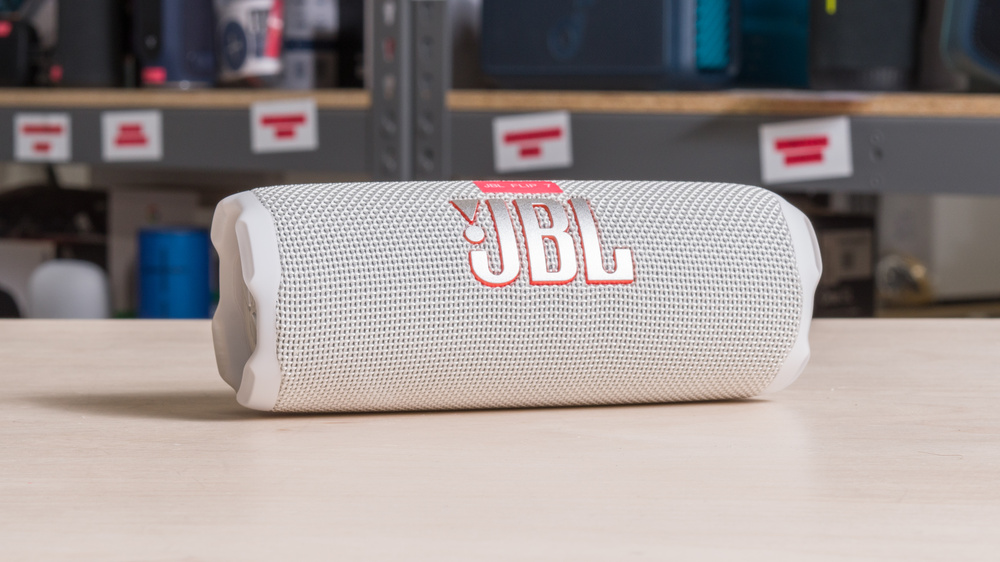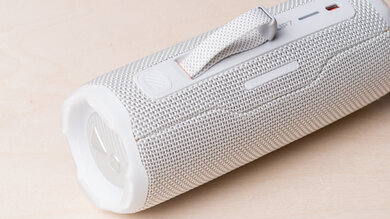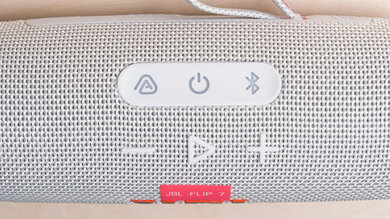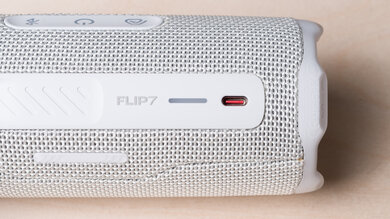The JBL Flip 7 is the smallest of the brand's tubular Bluetooth speakers, about the size and shape of a water bottle. While not much has changed between it and the previous JBL Flip 6, like a high IP rating against dust and water exposure and the option to add more speakers for a louder party, the brand has also added AI, Auracast, and a novel system for adding accessories called PushLock.
Our Verdict
The JBL Flip 7 is not bad for music. While the bass output is limited by the size of the speaker, it still extends low enough to give your kicks some boominess. It's otherwise rather flat for clear melodies and bright harmonics. You can also adjust the EQ settings. That said, it's a mono speaker, so it necessarily downmixes your audio, though you can pair a second compatible JBL speaker for stereo. It also tends to compress in the lows, so if you listen at close to max volume, the bass sounds weaker.
-
Multi-device pairing.
-
Graphic EQ and presets.
-
Unimpressive battery life.
-
Downmixes stereo audio to mono.
The JBL Flip 7 is disappointing for videos and movies. Unfortunately, this speaker has high enough latency that it can result in a mismatch between your audio and your video. It's a bit lower if you use the USB-C port for a wired connection. Still, it downmixes to mono and isn't very immersive when it comes to blockbuster action flicks, robbing bassy explosions of their rumble, especially at high volumes.
-
Graphic EQ and presets.
-
Unimpressive battery life.
-
High latency.
-
Downmixes stereo audio to mono.
The JBL Flip 7 is very good for podcasts. It's small enough to tote from room to room or on the patio, and since it reproduces mids and treble with clarity, voices sound natural. You can also connect to two devices simultaneously, so you can control the speaker seamlessly from your phone or laptop.
-
Multi-device pairing.
-
Graphic EQ and presets.
-
Unimpressive battery life.
The JBL Flip 7 doesn't have a microphone, so there's no voice assistant capability.
The JBL Flip 7 is decent for use outdoors. It gets loud enough with an even sound with good clarity, and has an app full of EQ options too. It has an IP68 rating, and it's advertised to withstand a one-meter drop, so it can handle the elements, and it fits into most cupholders and backpacks. You can add a second compatible speaker via Auracast or sync several compatible speakers in Party Mode. Its controls are intuitive and simple to use. On the downside, the battery life falls short of the advertised time, and while you can extend it by switching to PlayTime Boost, the extra time comes at the cost of frequency response accuracy, by rolling off bass. It's also a mono speaker, which is fine for podcasts, but it can't provide a wide soundstage.
-
IP68 rating.
-
Multi-device pairing.
-
Unimpressive battery life.
-
Downmixes stereo audio to mono.
- 6.3 Music
- 5.4 Videos/Movies
- 7.7 Podcasts
- 3.0 Voice Assistant
- 7.2 Outdoors
Changelog
-
Updated Jun 13, 2025:
We referenced the LG xboom Grab in the Voice Assistant box.
- Updated May 29, 2025: Review published.
- Updated May 23, 2025: Early access published.
- Updated May 05, 2025: Our testers have started testing this product.
- Updated Apr 15, 2025: The product has arrived in our lab, and our testers will start evaluating it soon.
Differences Between Sizes And Variants
The JBL Flip 7 comes in several eye-catching colors, all of which we expect to perform the same. Our unit is 'White' (here's a photo of its label). You can also choose from 'Blue,' 'Red,' 'Black,' 'Squad,' 'Purple,' and 'Pink.'
If you encounter any other variants of this speaker, let us know in the forums, and we'll update our review.
Compared To Other Speakers
The JBL Flip 7 is the smaller sibling of the JBL Charge 6, which, despite the lower number, is actually from the same generation of portable speakers. Due to its larger size, the Charge 6 houses a larger battery, effectively doubling how long it lasts compared to the Flip 7, and the Charge 6 is capable of greater low-end extension for a bit more even bass. You can even mate them up using Auracast for Party Boost Mode, or add a second Flip 7 instead for a stereo pair. That said, if you own the previous JBL Flip 6, you can't mate it to the Flip 7, which has been the case with nearly every new generation of Flip and Charge speakers: they're not backward compatible. New to the Flip 7 is USB-C audio for a wired connection, which is absent on the Flip 6. Looking at other options on the market, the Ultimate Ears BOOM 4 is a similar size and weight compared to the Flip 7, with a considerably better soundstage, meaning it sounds almost the same from all angles, and a longer battery life. However, the Ultimate Ears isn't as balanced by default or capable of as much low-end extension, and it also lacks a wired connection as on the JBL.
For more speakers you can take on the go, check out the best outdoor speakers. Get the lowdown on the best JBL speakers and the best speaker brands.
The JBL Flip 7 and JBL Flip 6 are so alike that price may determine your choice, and you can't mix and match the generations for stereo pairs. However, there are some differences. The Flip 7 has a slightly higher IP68 rating, and it's advertised to be drop resistant up to a meter, compared to the IP67 rating on the Flip 6. The Flip 7 also lets you skip back a track on the controls, and it adds a USB audio connection. Choosing PlayTime Boost lets you extend the battery life. That said, the Flip 6 compresses a little less at max volume, and it has most of the same features and functionality as the next gen.
The JBL Charge 6 is the step up model from the JBL Flip 7, and despite the number difference, they're from the same generation of speakers. They share similar tech specs: Auracast for pairing with other compatible JBL speakers, graphic EQ, and Play Time Boost (to extend the battery life). The Charge 6 weighs about double the Flip 7, though it's still portable. Due to its larger size, it reproduces more low-end. The Charge 6 also has more than twice the battery life. The central reason to buy the Flip 7 is that it's smaller and offers similar tech in a smaller package, but it's hampered by a little more compression at max volume, not as much bass extension, and a lower battery life.
Whether you choose the JBL Charge 5 or JBL Flip 7 depends on a couple of key features: portability and battery life. The JBL Flip 7 is lighter weight and a bit smaller. Its IP68 rating with one meter drop resistance is a little tougher. It has more in-depth app features, like PlayTime Boost, to extend the battery life. However, the Charge 5 has a slightly fuller low-end and a longer battery life with lower latency when streaming videos. Still, it lacks the USB audio found on the Flip 7, so your choice will depend mainly on battery life and weight, depending on your needs.
Choosing between the Sony ULT FIELD 1 and JBL Flip 7 partly depends on whether you plan to add a second speaker or not. Of the two, only the JBL can connect to a second compatible speaker for stereo, or a few for Party mode. The JBL also has a higher IP68 rating and is advertised to be drop-resistant up to a meter. It even recharges faster than the Sony, though the battery is a little shorter. The Sony has a slightly more excited sound with more boom and treble. The Sony boasts a slightly lesser IP67 rating, but we found it floats. It also has a microphone for voice assistance, which the JBL doesn't. That said, for video streaming, the Sony has much lower latency for a tighter A/V sync.
Test Results
The JBL Flip 7 strongly resembles the last generation, the JBL Flip 6. It's a small cylindrical speaker meant to rest horizontally. Each end has a bass radiator capped with protective silicone bumps that are a bit more angular than on the previous model. Otherwise, the buttons are along the top, and a large logo adorns the front. Our model is 'White,' but you can choose from a wide array of (mostly) single-color variants.
New to this generation is the brand's 'PushLock' design, which allows you to connect the included carabiner and loop strap by just plugging it into the speaker's designated slot and without fussing with threading a strap through a loop. Or, for a cleaner look, you can easily remove it when you're at home, and the speaker stays mostly in place. That said, if you lose the strap or carabiner, you'll need to get another, which may require contacting JBL.
The speaker is remarkably portable. It fits in most backpacks' water bottle pockets and can be carried single-handed, so wherever you go, it can too. The included strap and carabiner allow you to hook it onto your bag to soundtrack your hike.
The speaker has a superb build quality. While the JBL Flip 6 has a more than adequate IP67 rating, the JBL Flip 7 is a little more waterproof with an IP68 rating, and according to the manufacturer, it's drop-resistant up to 1 m, but it lacks a specific IK rating. The four ridges on the silicone end caps offer some shock absorption, while the rest of the speaker is made of a hard, plastic mesh. That said, the speaker won't float, but thanks to the band of silicone on the underside, it's unlikely to roll into the water if you leave it poolside. Its accessory strap and carabiner hook are nicely made, too. Despite the IP rating, the USB-C port lacks a cover to keep it free of debris.
The speaker has alright controls (you can see them here), mostly available along the top with clear labels to remove any guesswork. Basics like volume and playback are immediately obvious without needing to grab a manual, though there are some secondary functions like pressing 'Play/Pause' twice to skip to the next track, or three times to skip back. There's also an Auracast button to a second compatible JBL speaker for Party Mode, and if you want to add a third compatible speaker, you'll press the Auracast button on the second speaker, and so on.
There aren't many chimes to interrupt your audio, but there are audible indications for device connection and when you max out volume. Minimum volume, timed auto-off, volume changes, and device disconnections are silent, though.
The JBL Flip 7 has an even frequency response with a reasonable low-frequency extension given its size. It uses AI Sound Boost, which automatically changes the tuning to best represent the audio. You can't disable the function, so we can't compare its performance. The speaker sounds fairly even with a slightly less bassy sound than the JBL Flip 6, though it's subtle, with less boom in the low-end and a slightly duller low-treble. That said, you can also make adjustments in the app to taste. Overall, it's a reasonably neutral tuning to ensure clear voices and melodies that cut through the mix, while kick drums aren't weighty, they're still present.
The default tuning is the 'Signature' preset, but you can see how the other presets affect the tuning.
The soundstage is fair. It's a mono speaker and it's sensitive to listening angles. So, if you aren't facing the front of the speaker, the treble region sound is comparatively muffled and dark, which is pretty normal. If you prefer a speaker with more flexibility when it comes to listening angles, check out the Ultimate Ears WONDERBOOM 4.
For its size, the speaker reaches a respectably high max output volume, which is loud enough for a picnic or jamming to your tunes while cooking dinner. At max volume, the bass is compressed, which can introduce pumping and artifacts to your music.
The JBL Flip 7 has middling battery performance. While it's advertised to reach 14 hours of playback, we measured 5.6 hours using our standard test. There's a battery-conserving function called PlayTime Boost, advertised to extend the battery by two hours, and it does this by altering the EQ (with less bass, as you can see here), and we measured 9.5 hours of battery life with this mode. Speaking of battery conservation, if you leave the speaker idle for 25 minutes, it'll automatically shut down. While the battery charges, you can still connect via Bluetooth and listen to the audio through the speaker.
Since the speaker doesn't include its own USB-C cable or adapter for charging, we used our own, capable of outputting 60W, which took over 2.5 hours. Unlike the JBL Charge 6, you can't use the speaker's built-in battery to charge other devices.
This speaker doesn't have a microphone, but if you're looking for a comparable model that will support your phone's Siri or Google Assistant, consider the LG xboom Grab.
The JBL Portable app is very good, especially if you like to tweak your tuning; take a look at the app. You can choose between EQ presets: 'Signature' (by default), 'Chill,' 'Energetic,' and 'Vocal. Besides that, you can create one custom preset using the seven-band EQ. You can also enable PlayTime Boost, which alters the sound to be brighter in order to extend the battery life.
Other features center mainly around adding speakers. There's Party Mode to group multiple compatible JBL speakers and Stereo Mode for adding a second identical Flip 7 speaker. You can control these via the app, so changes are synchronized across the speakers. This is an Auracast speaker, but it only connects to the same generation of Auracast JBL speakers, and it's not backward compatible with older JBL speakers either.
New to the JBL Flip 7 is USB audio via its USB-C port. You'll need to provide the cable, though. You enable wired listening by pressing the 'Play' button while connecting the cable to the USB-C port. Using the wired connection means it can playback lossless files without additional compression. Latency is around 100 ms, so if you decide to watch video, it's on the borderline, but you may notice some mismatch. Some apps compensate differently, though, so your results may vary.
The speaker lets you simultaneously connect to two devices at once without having to pause playback. Latency is a bit high, which is fine for music, but if you stream video, you may encounter lip sync mismatch. However, some apps and devices can compensate for this differently.








